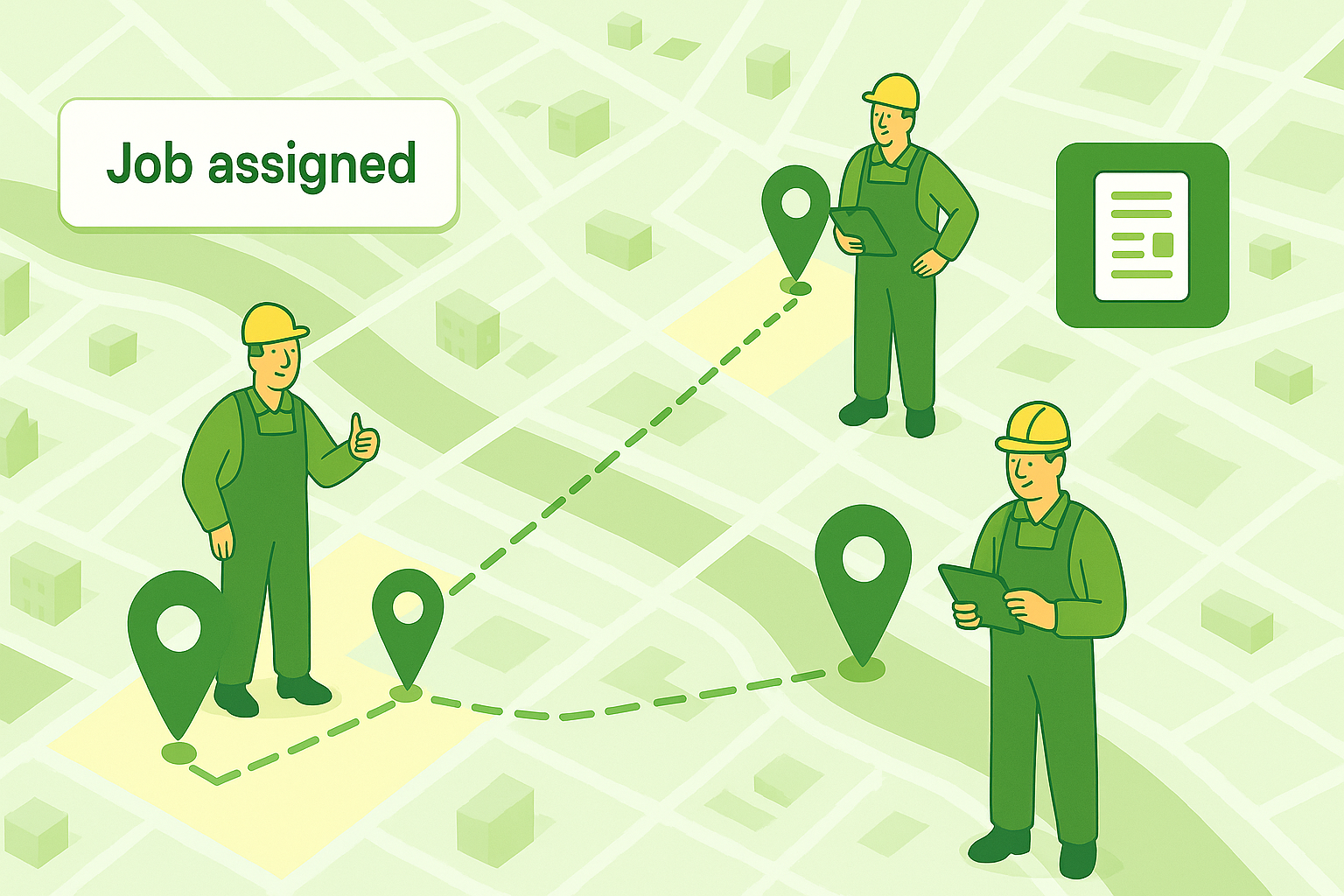
In every company that works on-site — fixing, installing, or maintaining equipment — there’s one person who keeps the whole system running smoothly. That person is the field service technician. So, what is a field service technician, really? They’re the professionals who travel to customer locations to diagnose issues, repair systems, and make sure everything works as it should. Without them, even the best-designed service plan would fall apart in practice.
A good field service technician job description covers much more than just technical ability. It’s about responsibility, communication, and precision — knowing how to solve a problem when you’re the only one on-site, miles from the office. These technicians keep equipment working, but they also keep relationships with clients intact.
Over the last few years, field service technology has changed how they do that job. Mobile apps, automation tools, and digital checklists now handle what used to be endless calls and paperwork. The technician’s toolbox has gone far beyond wrenches and meters — it now includes data, analytics, and instant communication.
In this article, we’ll look closer at what a field service technician does, what skills define them, and how new technology helps them deliver faster, more reliable service every day.
##What Is a Field Service Technician and Why This Role Matters

The job title sounds straightforward, but the work behind it rarely is. A field service technician juggles technical know-how with quick judgment and a fair amount of independence. One day they might be fixing a cooling system in an office, the next — calibrating a production line or troubleshooting a server in some loud, windowless room. It’s hands-on work, often unpredictable, but when they’re not there, things stop running as they should.
So what does a field service technician really do, once you look past the job title? Most days, it means driving out to where the problem is — fixing what’s broken, tuning what’s off, or installing something new before the next call comes in. One week it’s an air-conditioning unit; the next, an electrical panel or a machine that runs mostly on software.
The job isn’t repetitive. The place changes, the systems change, and so do the people waiting for things to start working again. It’s a mix of routine and improvisation that keeps everything — and everyone — moving.
In modern service businesses, field technicians play a dual role. They’re not just problem solvers but also the eyes and ears of the company in the field. When they notice recurring issues or inefficiencies, that feedback helps improve operations back at the office.
Their job is both technical and human — understanding machinery as well as people. With every visit, they maintain the company’s reputation, one repaired system or successful installation at a time. A skilled technician doesn’t just fix problems; they make reliability part of the brand.
If you’re wondering what does a field service technician do all day, the answer depends on where they work — but the rhythm stays familiar. They start early, check their assigned jobs, grab the right tools, and head out to wherever the next problem waits. Most of the job happens away from the office, often alone, with a mix of routine checks and sudden surprises that demand quick thinking.
A day might begin with a scheduled inspection and end with an urgent repair no one saw coming. Between those two, there’s a lot of driving, updating, testing, and talking with clients who just want things working again. It’s not glamorous, but it’s what keeps entire systems alive.
A field service technician job description sounds straightforward until you see how much depends on that role. They inspect equipment, diagnose faults, replace parts, and make sure everything runs safely. But that’s only half the story. They also explain the problem to the client, fill out service reports, and update the team so the next visit can be faster.
Good technicians combine technical skill with people skills. They know how to read a wiring diagram and how to calm a frustrated customer — sometimes in the same minute. Every visit builds trust, and every successful repair keeps the business running.

Every repair has a backstory. Before a technician even picks up a wrench, there’s a plan in motion — and that’s what field service maintenance really is. It’s the quiet part of the job, the one that keeps equipment from failing in the first place. Instead of waiting for something to stop working, technicians watch for early signs: vibration, heat, a small reading that’s slightly off. Those details tell them more than any alarm ever could.
Over time, these checks build a kind of memory for each system. The data shows which parts wear faster, when replacements actually make sense, and where the next failure might happen. It’s slow, methodical work, but it saves companies hours of downtime and piles of repair costs.
Technology helps, of course, but not in a flashy way. With mobile apps and smart scheduling, technicians can record data right on-site, update reports before leaving the customer’s location, and adjust future maintenance in real time. It’s not about eliminating human input — it’s about giving experts better visibility so they can act before the problem grows. Preventive work rarely gets applause, but it’s what keeps the phone from ringing with emergencies.
If you manage field teams, think about how much time disappears into coordination — messages, reports, missed updates. Tools like Planado simplify that part. They help field technicians plan routes, log their work instantly, and keep everyone informed without constant calls. Less stress, more focus, better results.
##What Skills and Qualifications Define a Professional Field Service Technician You can teach someone how to replace a part or follow a checklist, but that’s not what makes a good technician. What separates a professional from an amateur is the mix of discipline, instinct, and adaptability that comes only from experience.
A strong field technician knows how to read a technical manual — and when to ignore it. They can troubleshoot without panic, work safely under pressure, and explain complex problems in plain language. Some days, they deal with machines; other days, they deal with people who are tired, frustrated, and losing money by the minute.
Training and certification matter, of course. Most companies look for candidates with mechanical or electrical backgrounds, often supported by vocational programs or apprenticeships. But degrees alone don’t cover the field. Real expertise comes from being on-site, solving problems where there’s no manual and no backup.
In tech-heavy environments, this role overlaps with that of an IT field support technician or a field support specialist, where digital systems and hardware meet. These technicians understand not just tools and wires, but also how data flows through a network or how a sensor misreading can bring an entire operation to a halt. The best ones are calm under pressure, curious by nature, and endlessly patient — because in field work, fixing the issue is only half the job; keeping the client confident is the other half.
##Field Service Technology: How It Transforms Technician Workflows

The work hasn’t changed as much as the tools have. What used to be handled with clipboards, radio calls, and handwritten notes now happens inside a connected system. That’s the real value of field service technology — it turns a dozen small, time-consuming actions into one continuous process.
Modern tools don’t replace the technician’s expertise; they extend it. Information travels faster, tasks update themselves, and decisions that used to take hours happen in minutes. The result isn’t just speed — it’s fewer mistakes, better timing, and less noise between people who need to stay in sync.
For a technician in the field, the phone has quietly become as important as the wrench. Real-time updates mean that as soon as a job is finished or delayed, the rest of the team knows. Schedules shift automatically; no one has to call in or wait for the next meeting.
Mobile apps also make paperwork vanish. Reports can be filled out on-site, photos attached, signatures collected, all before leaving the customer’s location. It’s simple, but it’s what turns scattered notes into clear records — the kind that actually help with planning the next job.
The more data a technician records, the less guessing the company needs to do later. Over time, those small entries form a picture of how each machine behaves — when it slows down, what causes wear, how often it needs attention.
Predictive systems use that information to act early. They flag patterns, suggest replacements, and even reorder parts before something breaks. It’s not about watching screens all day; it’s about seeing what’s coming instead of cleaning up what’s already gone wrong.
The best tools for field teams don’t just collect data — they make work feel less fragmented. Planado brings all the moving parts together in one place: schedules, routes, photos, signatures, reports. Everything that used to be handled through calls and texts now lives inside a system that’s easy to follow and hard to lose track of.
With real-time visibility, technicians always know where they’re going next and what’s already done. Managers see progress unfold without chasing updates. It’s the quiet efficiency that comes from good design — no noise, no clutter, just work moving forward.
Planado also builds on the strengths of field service technology. It connects mobile tools, automation, and reporting into a single flow that feels natural for the people who actually use it. Instead of juggling apps and spreadsheets, teams have a single place to plan, record, and adjust. If your technicians spend more time coordinating than repairing, it might be time to try something simpler. Planado helps field service teams cut through routine and focus on what keeps customers happy — clean reports, quick updates, and jobs done right the first time.
What experience do you need to be a field technician? Most technicians start with a background in mechanics, electronics, or IT. Experience comes from hands-on work — being on-site, fixing real problems, and learning what no manual can teach. Curiosity and patience matter as much as formal training.
How has technology changed the field service technician job description? Technology replaced the guesswork. Today, a field service technician job description includes using mobile tools, automation, and real-time reporting as much as wrenches or meters. The job feels faster, cleaner, and far more connected than it did a decade ago.
What industries employ field service technicians most often? Almost any industry that depends on equipment or infrastructure does — manufacturing, telecom, HVAC, healthcare, and energy. Some roles lean mechanical, others digital. Wherever things need to keep running, technicians follow.
What is the difference between an IT field support technician and a field service technician? An IT field support technician focuses on networks, servers, and software issues. A field service technician handles the physical side — machinery, wiring, installations, and repairs. Both jobs overlap more each year as technology merges the digital and the mechanical.
